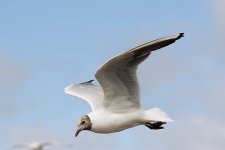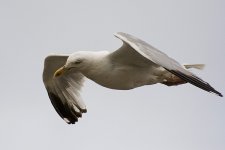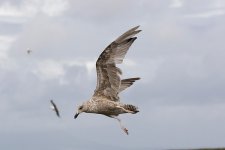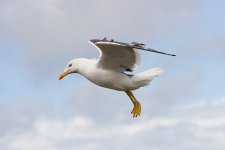I've just completed some slightly more controlled testing to reconfirm for myself just where the thresholds do lie. I also checked out what difference HTP makes on my 40D.
My test subject was my LCD TV screen, attached to my PC, with a pure white background for the desktop. This was to remove any chance of variable lighting throughout the short duration of the test - 45 seconds to capture all 16 test images. I sat the camera on a tripod and filled the frame with the white part of the screen only. I set ISO to 200 and aperture to f/2.8 and then tried different exposures simply by manually adjusting shutter speed. First I had HTP disabled and fired a sequence starting at +2 on the meter and then continued in 1/3 stop intervals right up to + 4 1/3. I then enabled HTP and fired off the exact same sequence of exposures again.
Here are the comparative results when viewed in DPP....
The top row is without HTP and the bottom row is with HTP. It may be difficult to tell from this screen capture but I checked every frame individually and, in the top row, the first signs of clipping appear in the 6th frame, exposed at + 3 2/3 above 0 on the meter. That means on the 40D that I actually have 3 1/3 stops of clear headroom above the metered 0 point. As a side note, on my 30D, the safe zone is 3 stops and not 3 1/3 due to the higher sensitivity of the 30D at any given ISO setting. i.e. a reported 100 ISO is actually equivalent to 125 ISO and so on ,right through the entire ISO range. This is discussed in the DPReview review of the 40D, I think.
In the bottom row, with HTP enabled, the first three exposures - up to + 2 2/3 look pretty much identical to me. In the fourth exposure (at + 3 stops) there seems to be a slight hot spot (not actually blown, just hot) in the centre of the image in the top row, which is absent in the equivalent shot in the bottom row. As we progress to the right, through higher and higher exposures, the bottom row still shows a more gradual progression through light greys, without blowing out. In contrast the top row is getting more and more blown above +3 1/3 stops. Basically, with HTP enabled the image was still not blown even at + 4 1/3 over 0 on the meter. Yet lower down the tonal scale the images looked identical for practical purposes.
So I have no doubt that HTP is effective and works well when shooting raw and processing in DPP. I don't know how in camera jpegs would fare as I never shoot jpeg. I imagine the benefit would be there to see too.
Now for the bad news. I ran the same images through Lightroom 2 and as far as I could tell by eye, by histogram and by clipping warnings, there was no significant difference at all between the shots with HTP enabled and those without. In other words HTP seems to have no beneficial effect in raw processors other than Canon's own (well, not in Lightroom at any rate). Here is an equivalent screen capture from Lightroom....
http://farm4.static.flickr.com/3073/2766635453_35eee0c79c_b.jpg
On that basis I have no idea how the raw files differ with HTP on or off. How can Lightroom interpret pixels as blown when DPP knows they are not? Either a pixel is blown out, in terms of its absolute data value, or it is not. Maybe DPP is doing some kind of internal automatic highlight recovery, not available as a manual control in the software. In Lightroom it was easy enough to recover highlights with only modest amounts of highlight recovery, certainly at the + 3 1/3 and +3 2/3 exposure levels. At +4 a lot more recovery was required, and with a pure white target as the subject it's impossible to tell how effective the recovery was.
What I do know is that with a....
- 30D I have 3 stops of headroom before blowing anything;
- 40D and HTP disabled I have 3 1/3 stops of headroom before blowing anything;
- 40D and HTP enabled I have 4 1/3 stops headroom, and maybe a fraction more, although I stopped testing at + 4 1/3, so I don't know the upper limit.
I leave it up to you to do with that information what you will









